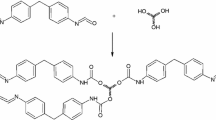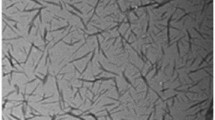Abstract
Completely amorphous copoly(ether)ester networks based on oligo(propylene glycol) and oligo[(rac-dilactide)-co-glycolide] segments were synthesized by crosslinking star-shaped hydroxyl-telechelic cooligomers using an aliphatic low-molecular weight diisocyanate. Two different network architectures were applied exhibiting differences in the phase-separation behavior. For networks from oligo(propylene glycol)-block-oligo[(rac-lactide)-co-glycolide] triols (G3OPG-bl-OLG) only one glass transition was obtained. However, networks from a mixture of oligo(propylene glycol) triols (G3OPG) and oligo[(rac-lactide)-co-glycolide] tetrols (P4OLG) with a ratio of components in a certain range show two glass transition temperatures (T g) being attributed to two segregated amorphous phases. In this way a wide spectrum of mechanical properties can be realized and adjusted to the requirements of a specific application.







Similar content being viewed by others
References
Roby MS, Kennedy J Sutures. Biomaterial Science: An Introduction to Materials in Medicine. San Diego: Elsevier; 2004. p. 615.
Langer R, Vacanti JP. Tissue engineering. Science. 1993;260:920–6. doi:10.1126/science.8493529.
Li SM. Hydrolytic degradation characteristics of aliphatic polyesters derived from lactic and glycolic acids. J Biomed Mater Res. 1999;48:342–53. doi:10.1002/(SICI)1097-4636(1999)48:3<342::AID-JBM20>3.0.CO;2-7.
Jabbal-Gill I, Lin W, Kistner O, Davis SS, Illum L. Polymeric lamellar substrate particles for intranasal vaccination. Adv Drug Deliv Rev. 2001;51:97–111. doi:10.1016/S0169-409X(01)00173-9.
Witschi C, Doelker E. Influence of the microencapsulation method and peptide loading on poly(lactic acid) and poly(lactic-co-glycolic acid) degradation during in vitro testing. J Control Release. 1998;51:327–41. doi:10.1016/S0168-3659(97)00188-0.
Edelman ER, Nathan A, Katada M, Gates J, Karnovsky MJ. Perivascular graft heparin delivery using biodegradable polymer wraps. Biomaterials. 2000;21:2279–86. doi:10.1016/S0142-9612(00)00154-X.
Choi NY, Lendlein A. Degradable shape-memory polymer networks from oligo[(l-lactide)-ran-glycolide]dimethacrylates. Soft Matter. 2007;3:1–10. doi:10.1039/b702515g.
Bertmer M, Buda A, Blomenkamp-Höfges I, Kelch S, Lendlein A. Biodegradable shape-memory polymer networks: characterization with solid-state NMR. Macromolecules. 2005;38:3793–9. doi:10.1021/ma0501489.
Storey RF, Hickey TP. Degradable polyurethane networks based on d,l-lactide, glycolide, e-caprolactone and trimethylene carbonate homopolyester and copolyester triols. Polymer (Guildf). 1994;35:830–8. doi:10.1016/0032-3861(94)90882-6.
Kelch S, Choi NY, Wang Z, Lendlein A. Amorphous, elastic AB copolymer networks from acrylates and poly[(l-lactide)-ran-glycolide]dimethacrylates. Adv Eng Mater. 2008;10:494–502. doi:10.1002/adem.200700339.
Choi NY, Kelch S, Lendlein A. Synthesis, shape-memory functionality and hydrolytical degradation studies on polymer networks from poly(rac-lactide)b-poly(propylene oxide)-b-poly(rac-lactide) dimethacrylates. Adv Eng Mater. 2006;8:439–45. doi:10.1002/adem.200600020.
Smith SW, Freeman BD, Hall CK. Pressure-dependent photon correlation spectroscopic investigation of poly(propylene oxide) near the glass transition. Macromolecules. 1997;30:2052–7. doi:10.1021/ma960408+.
Alteheld A, Feng YK, Kelch S, Lendlein A. Biodegradable, amorphous copolyester-urethane networks having shape-memory properties. Angew Chem Int Ed. 2005;44:1188–92. doi:10.1002/anie.200461360.
Amsden B. Curable, biodegradable elastomers: emerging biomaterials for drug delivery and tissue engineering. Soft Matter. 2007;3:1335–48. doi:10.1039/b707472g.
Helminen A, Korhonen H, Seppälä JV. Biodegradable crosslinked polymers based on triethoxysilane terminated polylactide oligomers. Polymer (Guildf). 2001;42:3345–53. doi:10.1016/S0032-3861(00)00708-4.
Hild G. Model networks based on ‘endlinking’ processes: Synthesis, structure and properties. Prog Polym Sci. 1998;23:1019–149. doi:10.1016/S0079-6700(97)00055-5.
Palmgreen R, Karlsson S, Albertsson A-C. Synthesis of degradable crosslinked polymers based on 1, 5-dioxepan-2-one and crosslinker of bis-e-caprolactone type. J Polym Sci Part Polym Chem. 1997;35:1635–49. doi:10.1002/(SICI)1099-0518(19970715)35:9<1635::AID-POLA5>3.0.CO;2-Q.
Pitt CG, Hendren RW, Schindler A, Woodward SC. The enzymatic surface erosion of aliphatic polyesters. J Control Release. 1984;1:3–14. doi:10.1016/0168-3659(84)90016-6.
Valette L, Hsu CP. Polyurethane and unsaturated polyester hybrid networks: 2: influence of hard domains on mechanical properties. Polymer (Guildf). 1999;40:2059–70. doi:10.1016/S0032-3861(98)00428-5.
Younes HM, Bravo-Grimaldo E, Amsden BG. Synthesis, characterization and in vitro degradation of a biodegradable elastomer. Biomaterials. 2004;25:5261–9. doi:10.1016/j.biomaterials.2003.12.024.
Lendlein A, Neuenschwander P, Suter UW. Hydroxy-telechelic copolyesters with well defined sequence structure through ring-opening polymerization. Macromol Chem Phys. 2000;201:1067–76. doi:10.1002/1521-3935(20000701)201:11<1067::AID-MACP1067>3.0.CO;2-Y.
Yamaguchi K, Anderson JM. In vivo biocompatibility studies of medisorb® 65/35 d,l-lactide/glycolide copolymer microspheres. J Control Release. 1993;26:81–93. doi:10.1016/0168-3659(93)90169-6.
Author information
Authors and Affiliations
Corresponding author
Rights and permissions
About this article
Cite this article
Zotzmann, J., Alteheld, A., Behl, M. et al. Amorphous phase-segregated copoly(ether)esterurethane thermoset networks with oligo(propylene glycol) and oligo[(rac-lactide)-co-glycolide] segments: synthesis and characterization. J Mater Sci: Mater Med 20, 1815–1824 (2009). https://doi.org/10.1007/s10856-009-3761-x
Received:
Accepted:
Published:
Issue Date:
DOI: https://doi.org/10.1007/s10856-009-3761-x




